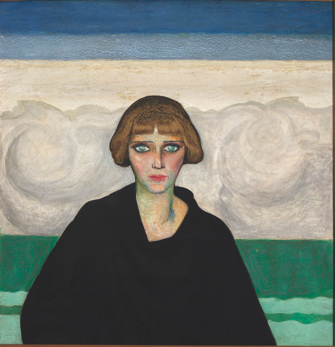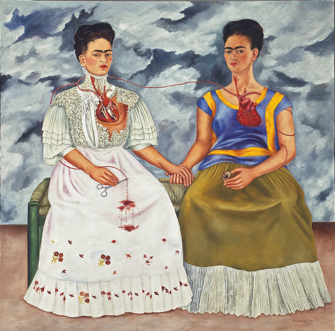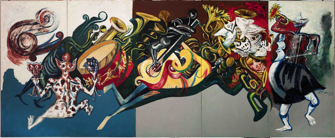
The exhibition “Mexico 1900-1950” at the Grand Palais aims to go beyond the Diego and Frida double act and provide a taste of the explosion of creative vitality, color and innovation that occurred in Mexico in the early part of the 20th century: the “Renacimiento Mexicano.”

The exhibition is wide-ranging – covering painting, mural design, sculpture and cinema – but it lacks the depth to explore in detail the work of the artists represented, except in the case of the muralists Jose Clemente Orozco,
David Alfaro Siqueiros and the iconic duo Diego Rivera/Frida Kahlo, all of which are already familiar names.
To inform visitors unfamiliar with important historical references, such as the end of the 35-year long Porfiro Diaz régime and the ensuing Mexican Revolution (1910-20), the Grand Palais provides a number of dry, verbose educational panels to explain why this vibrant artistic community made itself seen and heard beginning in the 1920s.
My own interest in this period in Mexican cultural history was sparked by an elderly aunt by the name of Marianne who had been brought up in Mexico City and who possessed at her home in Philadelphia an original and very exciting painting of a volcano by Dr. Atl (1875-1964). This painter, born Gerardo Murillo, was the grand old man of the Mexican creative community and a wonderful artist; it is regrettable that his work is not well represented in the exhibition.
Great-aunt Marianne, whose father was a renowned pediatrician in Mexico City, was a great name-dropper and told me about Diego Rivera and his friends, who were often invited to dinner at the house of her father, who had emigrated to Mexico from Switzerland around 1930. It was a time when many members of the European creative community went to Mexico, fleeing persecution at home.
Among the avant-garde exiles represented in the exhibition are the Frenchman Jean Charlot, one of Diego Rivera’s chief assistants in his mural paintings; Wolfgang Paalen; the Englishwoman Leonora Carrington; Italian photographer Tina Modotti; and the French actor-playwright Antonin Artaud, who once wrote, “The magical reality of another culture lives in Mexico, linked with the earth, lost in the flow of volcanic lava, vibrating in the blood
of the Indians.” Like Artaud, many of the artists arriving from Europe were fascinated and inspired by the Aztec, Maya and other indigenous cultures. Later, though, this indigenismo tendency was to be discredited as naive and patronizing.

Many works in the show feature fascinating and picturesque local costumes, among them “Oaxaca Indian Woman” by Mardono Magana and “Man with a Serape and Hat” by Ramón Cano Manilla.
Until my visit, I was not familiar with Nahui Olin (1893-1978), once the muse of Diego Rivera, Dr. Atl and many other Mexican artists. The beautiful and uninhibited Olin (real name: Carmen Mondragon) was a noted model, femme fatale, naive painter and poet. Her own painting, “Nahui and Agacino beside Manhattan Island,” offers a naked rear view of her as she embraces her lover, with New York visible through a porthole. Like Frida Kahlo, she integrated her life and her image into her art.
A number of works feature Olin, among them photographs and portraits. During Dr. Atl’s infatuation with the young model, he gave her her name in the Nahuatl language. Derived from Aztec cosmology, it means “the fourth movement of the regenerating force of the fifth sun.” She took it up enthusiastically.
We also find examples of work by artists of Mexico’s Post-Surrealist Stridentist movement, Ramón Alva de la Canal and Rafael Lozano-Hemmer. A section on Mexican artists who were successful in the United States includes the illustrator Miguel Covarrubias, whose wonderful political caricatures decorated the pages of Vanity Fair and The New Yorker in the 1940s.
It is to be regretted that there is little here about Mexican contemporary architecture, surely one of the country’s great achievements, beyond Juan O’Gorman’s 1976 “project for a Venus birth monument.” Where is the great architect Luis Barragán?
The cinema sequence, while intriguing, consists of a rather unsatisfactory set of short excerpts from Mexican movies projected simultaneously on three big screens. To see a complete screening, check the schedule to find the film that interests you and and return at a later date to see it. I wanted to see Emilio Fernández’s lyrical black-and-white movie La Perla, but I had great difficulty finding the screening room (it is upstairs from the Hergé exhibition) and ended up among an audience of Tintin fans watching a psychological analysis of the Belgian cartoonist’s opinions on culture.
Generally, the exhibition offers the problem of “where to start?” With its vast array of styles and artists, diverse influences and contrasts between the famous and obscure, it is somewhat confused and lacking in cohesion. It is certainly a pity that the curator did not include more on modern architecture and was unable to put his hands on some better paintings by Dr. Atl. Some other time, perhaps – Mexican Embassy cultural attaché, please take note.
Favorite